Traveler Special Report: Mixing Energy Development And National Parks
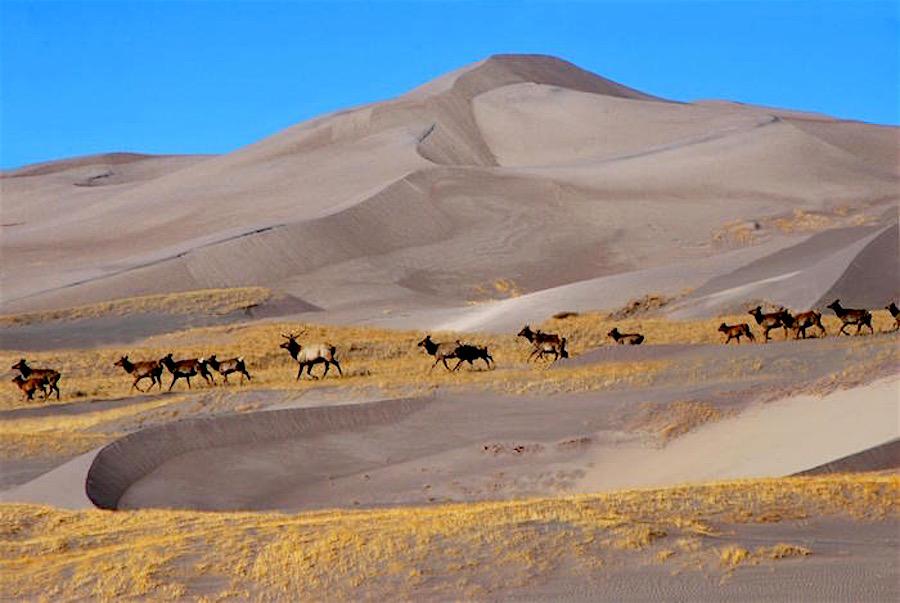
Great Sand Dunes National Park is just the latest unit of the National Park System that could be impacted by oil and gas development/NPS
Editor's note: While the U.S. Bureau of Land Management recently deferred the auction of oil and gas leases near Great Sand Dunes National Park and Preserve in Colorado, the issue of energy development is not dead there, nor in many other areas of the National Park System. Contributor John Miles, author of Wilderness in National Parks, takes a look at the state of oil and gas exploration in the park system in this article.
Great Sand Dunes National Park and Preserve in Colorado is two hours north of where I live near Taos, New Mexico. The dune field, the park’s unique natural feature, lies at the western foot of the Sangre de Cristo Mountains, and much of it is in the Great Sand Dunes Wilderness, a 33,548-acre piece of the National Wilderness Preservation System. Part of the preserve, which reaches to the summit of the Sangre de Cristo range east of the park, is in the Sangre de Cristo Wilderness.
On my most recent trip there, I learned that the Department of the Interior was proposing to lease 11 parcels on Bureau of Land Management land close to the park boundary, but I didn’t know which boundary. West of the park is the Baca National Wildlife Refuge and San Luis Lakes State Wildlife Area. Land to the south is managed for conservation by The Nature Conservancy. The proposed leases, it turns out, are located outside the east boundary of the park, on the other side of the mountains from the dune field, the primary attraction of the park. Development would not seem to impact the dunes visually, but might there be other problems for hikers and wildlife? Leasing proponents argue that development close to but not in a park should not be an issue. Others argue that often the valued resources of a park do not stop at the park boundary.
Lease advocates give assurances that the park will not be impacted, but the question arises as to why the BLM must encourage industrial development in a corner of Colorado so highly prized for its scenery and unique natural landscapes. Why not leave relatively wild and beautiful regions like this to the wildlife and seekers after the wonders of nature like the dunes and the beauty of such wild and scenic areas? As it turned out, the BLM last week deferred the auction planned for September to consult further with the Navajo Nation on lands that could be impacted.
Thinking about this while climbing the nearly 700-foot High Dune in the park, I remembered fellow New Englander President Calvin Coolidge’s pronouncement that, “The business of America is business.” Nearly a century after Coolidge said this in the 1920s, we seem to be back to thinking like he did, a very narrow way of defining the core values of our nation. National parks, I thought, refute this notion, or at least have until recently.
Concerned about the prospect of these leases and knowing about several other national park units threated by oil and gas development in or near them, like New Mexico’s Chaco
Culture National Historical Park and Colorado’s Dinosaur National Monument, I wondered how extensive such threats to national parks generally were in the Trump administration’s initiative to establish “energy dominance” by developing oil and gas everywhere possible and as quickly as possible. I decided to look into it.
First, I was surprised to learn that 12 units of the National Park System have active oil and gas wells today. These are not iconic parks like Yellowstone, Glacier, and Olympic national parks, but smaller parks like Aztec Ruins in New Mexico (4 wells), Big Cypress National Preserve in Florida (20 wells) Cuyahoga Valley National Recreation Area in Ohio (90 wells), and Lake Meredith National Recreation Area in Texas (174 wells). Twenty-seven other parks are vulnerable to drilling within them, including Everglades, Grand Teton, Mesa Verde, and Theodore Roosevelt National Parks.[i]
Drilling within National Park System units? How could this be? Clearly this practice did not start with the Trump administration, but would they take advantage of the precedent and relax any rules that might deter more park invasions?
Sure enough, in March 2017 President Trump issued an executive order requiring federal agencies to renew or rescind policies protecting parks from impacts of oil and gas development. This included National Park Service "9B" rules. Back in 1978, recognizing that on some of its units the government owned the surface lands while private companies owned mineral rights, the Park Service issued “9B” rules attempting to protect park resources while respecting private rights. As drilling technology evolved, a need emerged to update the rules, which the Park Service did in 2016 after a seven-year process.
The revised rules removed exemptions for 319 wells granted in the 1978 rules, which meant that the Park Service could not enforce safety standards and address problems such as leaks and spills and other impacts that might arise from these exempted wells. The new rules lifted a cap on unrealistically low bonding for cleanup and closing of wells that could leave taxpayers with big bills. They allowed the Park Service to charge fees to companies using surface land to access their operations, fees that could be used to repair damages caused by these operations. The Park Service was also given more authority to hold companies accountable should they fail to comply with agreed-to safety standards. These changes seemed to put some teeth into the 9B rules that the Park Service might need.
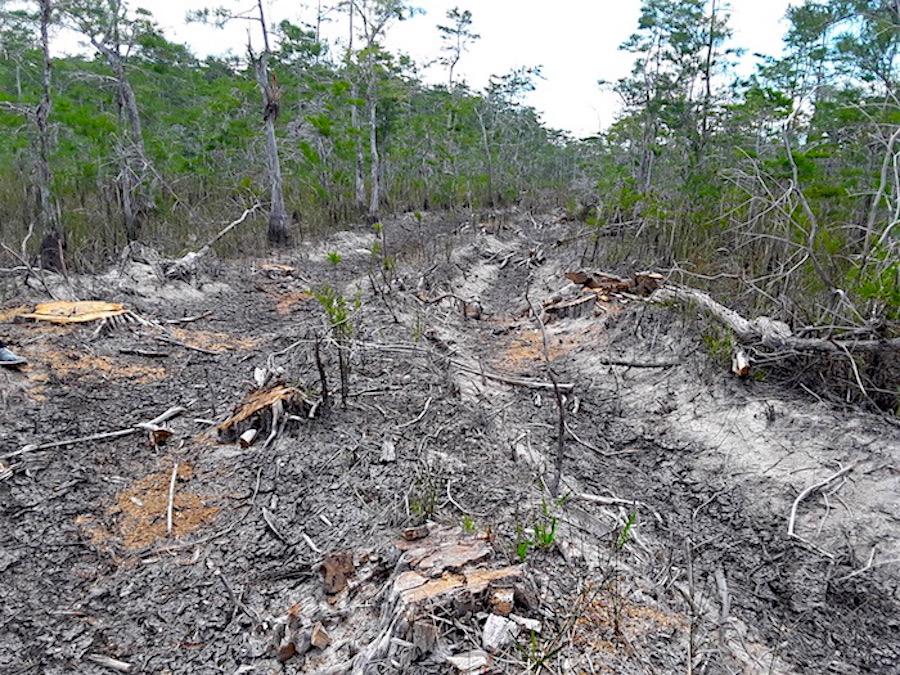
Oil and gas exploration has done extensive damage to the sensitive landscape of Big Cypress National Preserve, though Burnett Oil Co. has pledged to restore it/NRDC
Then, just last year, activity at Big Cypress National Reserve dramatically demonstrated the need for such rules. In 2017 a Texas oil company began a four-phase seismic survey in the Reserve. Such a survey requires 30-ton trucks to plough through the wetlands of this western Everglades reserve. The Park Service approved the survey and required specific measures to mitigate the impacts of the project. After the 2017 survey, conservation groups, which had unsuccessfully tried to block the project, went in to see if the company had complied with the Park Service’s mitigation requirements. They documented violation of at least six of them, finding that not only was the company not living up to its assurances to mitigate their impacts, but the Park Service did not seem to be requiring them to do so. This situation should not be surprising given the Interior Department thrust to develop oil and gas everywhere possible as quickly as possible. The Park Service is in Interior, and pressure on the agency to go along with administration priorities is well documented.
The fact that active oil and gas operations are present in national park units and possible in many more was shocking because it seemed to violate the very nature of the National Park System, but this ongoing violation is only the tip of the iceberg. A larger problem is leasing for oil and gas close to many national parks, as at Great Sand Dunes, among them some of the most popular and important parks. Most of these leases are on public land, usually managed by the BLM, and this agency is responsible for leasing on most onshore public lands. The National Parks Conservation Association reported in January 2018 that at least 13 Western national parks were being threatened by completed or in-progress lease sales close to them.
Threats vary.
At Great Sand Dunes, for instance, night winds blow from east to west, bringing any air pollution to the park. Deer, elk, and antelope move through the park and could be impacted. Visitors come for the dark skies and wilderness hiking and camping, all of which would be impacted by lighted and noisy drill operations close to the park.
Chaco Culture National Historical Park, designated a World Heritage Site by the United Nations Educational, Scientific, and Cultural Organization, is also at risk. The BLM scheduled a sale of 25 parcels near the park for March 2018, but Interior Zinke canceled the sale after protest from many, including tribes and New Mexico politicians, until a review could be conducted assessing impacts on cultural artifacts.
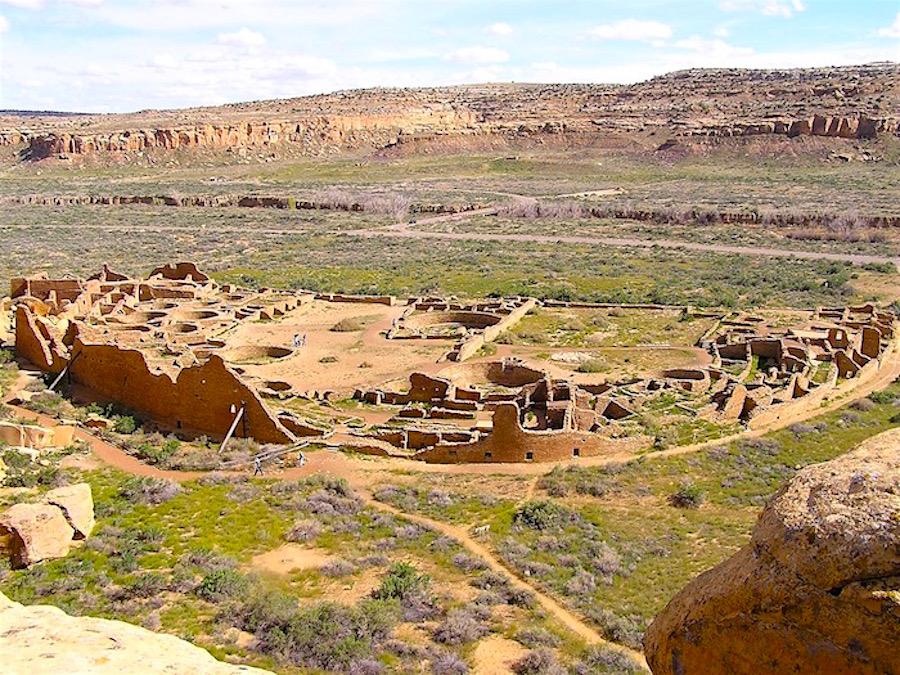
How might oil and gas exploration near Chaco Culture National Historical Park impact ancient travel corridors?/NPS
In April a federal judge rejected a lawsuit by tribes and environmental groups that sought an injunction against leasing in the Chaco area. Meanwhile, the oil and gas industry submitted “Expressions of Interest” to BLM for lease of 208 parcels totaling 55,000 acres in the region, and under a rollback of an Obama era policy the Trump administration ordered the BLM to process all such Expressions of Interest in six months and auction the lands as soon as possible. Archaeologists, using new tools, have documented a system of 1,000-year-old roads emanating from the great houses in Chaco Canyon and are concerned that oil and gas development will fragment ancient Chacoan landscapes. Impact on the ancient heritage of development will not be confined only to the current park.
The Chaco case raises several red flags to those seeking protection for the park and its archaeologically rich surroundings. Secretary Zinke’s 2016 “reviews” of national monuments were slapdash and inconsistent and bent on serving political interests. Will the Chaco review be any different? While such a review occurs, the industry presses ever harder to gain access to public lands in the Chaco region.
Elsewhere the Trump administration moves ahead with oil and gas development in the Arctic National Wildlife Refuge and other federal areas of concern. In such an environment, how can we be confident that “impacts on cultural artifacts” will be adequately assessed, a process that demands more thorough study of the area than has yet been done? Such study and care in the rush to development seems unlikely.
In August 2017, 350 retired Park Service veterans, members of The Coalition to Protect America’s National Parks signed a letter to Secretary Zinke. They wrote that park visitors “do not expect national parks that are surrounded by oil and gas rigs, shrouded in haze, and disrupted by noise from industrial activity. There are places where oil and gas development is entirely appropriate. But rarely do those places include the lands that surround national parks.”
The Coalition reminded the Secretary that in 2008 the Bush administration rushed sales of oil and gas leases next to Arches and Canyonlands national parks in Utah, only to have a federal court halt the leases. Out of this came changes to BLM leasing programs near parks, one of which was a process called Master Leasing Plans (MLPs) that would allow the Park Service to identify concerns and work with the BLM to resolve them. The Park Service veterans in their letter called upon the administration to continue policies adopted following the 2008 lease sale.
“Those policies, which include the Master Leasing Plan policy, are protecting our national parks, while reducing conflicts with proposed oil and gas development,” they wrote.
Sadly, their plea was ignored.
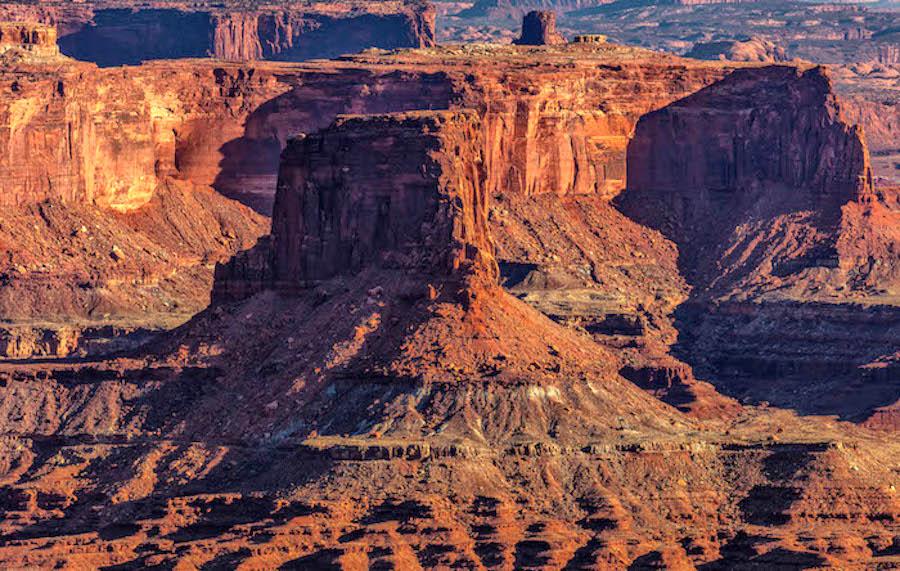
A Master Leasing Plan that the BLM approved for southeastern Utah around Canyonlands and Arches national parks was built with input from stakeholders./Rebecca Latson
In January 2018, the BLM issued policy guidance intended to speed up the leasing process, and as part of this, cancelled the Master Leasing Plan policy. Only one such plan, for Moab, Utah, had been completed, and other plans in progress or proposed were frozen. In the Moab MLP, leasing was restarted in contested areas.
The idea behind Master Leasing Planning was that landscape-level planning be done in areas like Moab in order to reduce conflicts between stakeholders, reduce litigation, and “supplement standard land-use planning in areas where fragile environments, popular outdoor recreation, or valuable cultural artifacts overlapped with drilling interests.”[ii] This action is irrefutable evidence that the Trump administration is not concerned about impact of leasing on the National Park System, despite what Secretary Zinke may say to the contrary. The message is, “Let’s get on the fast track for energy dominance, no matter the consequences to national parks.”
The BLM Master Leasing program or something like it, is what is needed to protect the parks as the Coalition to Protect America’s National Parks recognized. And they should know, given their cumulative thousands of years of service to these parks. As noted earlier, conflict arose over leasing in one of America’s most beautiful and iconic landscape near Arches and Canyonlands national parks. The upshot was that the BLM during the Obama administration launched a regional planning initiative that would give communities in national park landscapes a voice in decisions as to where oil and gave development should occur. It would allow tribes, local business owners and recreational enterprises potentially affected by oil and gas development and other stakeholders, including the industry, to weigh in on the decision. It would consider the cumulative effect of proposed development and work to protect parks while allowing development. What a common-sense approach! The Trump administration rescinded it.
Such an approach is nothing new to regional planners but is anathema to those who operate on the basis of “I want it now, whatever the side effects to anyone else may be!”
“MLP’s allowed stakeholders on the ground to work together to create landscape-level plans aimed at protecting outdoor recreation opportunities and providing economic certainly to local businesses and all industries that benefit from public lands," said Nicholas Lund, senior manager of the NPCA Landscape Conservation Program. "They insured that everyone who cares about public lands – from county commissioners to drillers to sportsmen to tribal and cultural interests – had a say before lands were leased.”[i]
The MLP approach or any such program that allowed stakeholders a role in decision-making when parks are at stake seems a win-win. It should reduce conflict and consequent litigation, giving a measure of assurance to all stakeholders in the landscape, including the oil and gas industry.
In addition to rescinding the MLP approach, the BLM leasing guidance restricted public participation in decision-making in other ways. It removed the requirement for full environmental assessments of lease sales, removed the requirement for BLM offices to provide for public participation in its environmental assessment of potential leases, and shortened the period for notice and appeal of lease sales. In short, the agency created a fast-track to lease sales and is attempting to cut the public out of the process. Of such moves as this, NPCA’s Lund says, “The Trump Administration is concertedly and systematically closing off avenues for the public to understand the impacts of oil and gas development on nearby parks, and eliminating opportunities for them to speak in favor of national park protection.”
In 2017, the National Park Service recorded more than 330 million recreation visits.[ii] This is surely an indicator that response to park threats of all kinds, perhaps especially oil and gas development, would be of concern to many if they knew the scope and scale of the threat. NPCA, NRDC, and other environmental groups are trying to get the word out, while fighting for public lands and the environment on many fronts. My concern for Great Sand Dunes has led to the revelation that not only are parks threatened by current policies, but so is the very process of defending them.
In many ways the current crises involving national parks are more severe than they have ever faced with oil and gas impacts being only one of many. But this is not the first time such crises have occurred. A pro-business administration and an ethically challenged Secretary of the Interior in the 1920s posed challenges to the still young National Park System. Strong advocates of national parks like Robert Sterling Yard of the National Parks Association (now the National Parks Conservation Association) fought against ill-conceived national park policies. Stephen Mather, a savvy businessman and founding director of the National Park Service, found ways to grow the agency. Interior Secretary Albert Fall was brought down by a scandal involving oil leases.
After World War II, the parks were in such shambles that prominent crusading writer Bernard DeVoto, using his Easy Chair column at Harper’s, brought the country’s attention to the park situation, going so far as to advocate the parks be closed until something could be done. He gets part of the credit for initiatives that soon addressed problems like a huge backlog of maintenance, another big challenge today. Now we have strong advocacy groups like the NPCA, NRDC, Sierra Club, and The Wilderness Society drawing attention to the problem in the spirit of Yard. We need more mainstream journalistic attention to the park crisis. We need to inform and galvanize to action many of the millions who love their national parks.
This is a large order in the face of all the other problems we face today, but unless we find ways to take these actions, the magnificent system of national parks we enjoy face death by a thousand cuts, or drills. As historian David McCullough wrote in his 2017 book,The American Spirit: Who We Are and What We Stand For, “A sense of history is an antidote to self-pity and self-importance, of which there is too much in our times. To a large degree history is a lesson in proportions.”[iii] These are trying times, but the American people have come to the defense of national parks for more than a century. They must again.
Traveler footnote: For more detailed information on this complex issue monitor National Parks Traveler and https://www.npca.org/articles, https://wilderness.org/seven-ways-oil-and-gas-drilling-bad-news-environment , NPCA/NRDC, “SpOILed Parks: The Threat to Our Coastal National Parks from Expanded Offshore Drilling”

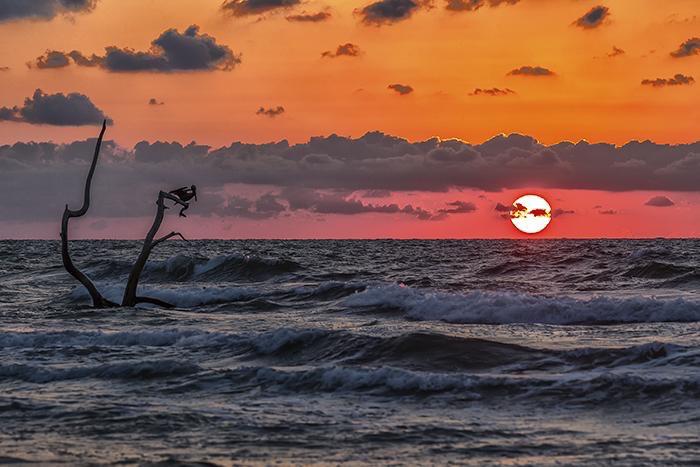

Comments
Two excellent articles in today's Traveler regarding challenges faced by too many of our parks when it comes to maintenance and threats to nearby lands.
But it's a shame that these two fine reports are published only here. They really need to be more widely broadcast.
What we really need in this country is a resurgence of the environmental concerns and actions of the late 1960's and early 1970's when public pressure forced Congress and the Nixon administration to act on clean air and water legislation. There were public service ads aired many times every day by all our TV stations, print ads in newspapers, editorial columns and books by such prominent people as Stewart Udall and many others.
How can we get something like that going again?
I find it telling that an individuall who I must assume is quite familiar with the National Parks would be surprised that hundreds of wells already exist in National Parks. Obviously their impact must not be so massively negative or surely he would have known.
A very faulty [and self serving] "obviously".
Or, they're mostly parks Lee (and you) are unlikely to have visited: Big Cypress, but also Big Thicket, Obed, Big South Fork, Gauley River, Lake Meredith, plus others I'd have to look up. EC, you "obviously" haven't been to BICY & BISO. [If I'm wrong, I owe you a beer if we ever meet in a park.]
Here's a link to an excellent and thoughtful op-ed in today's Salt Lake Tribune regarding the current administration's attack on environmental regulations:
https://www.sltrib.com/opinion/commentary/2018/07/22/commentary-trump/
And today, we discover that the Interior Department deliberately discounted or ignored information they didn't want to examine while working to reduce the sizes of Bears Ears and Escalante National Monuments. Ooops -- they accidentally released some FOIA materials before redacting portions that showed their efforts at cover-up.
But it's pretty foolish of anyone to expect honesty from Washington these days.
https://www.sltrib.com/news/politics/2018/07/23/retracted-documents-show/
https://www.sltrib.com/opinion/
Yes, and science, along with the precautionary principle is no longer valued:
https://www.revealnews.org/blog/top-interior-officials-ordered-parks-to-...